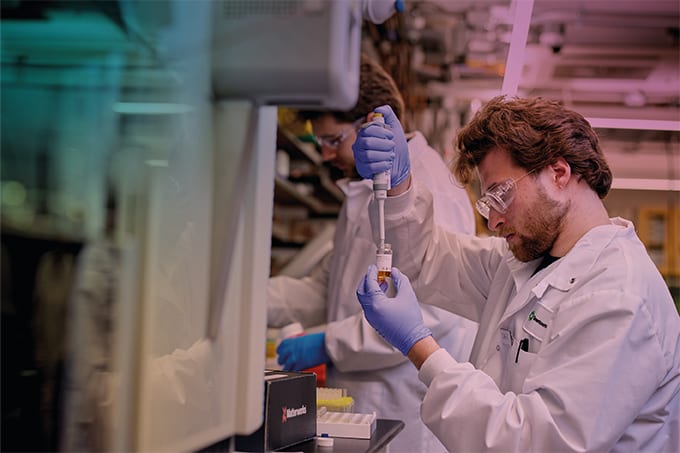
Researchers have combined stable-isotope-assisted NMR spectroscopy with long-timescale molecular dynamics simulations to probe how fucosylation and galactosylation reshape the conformational landscape of human IgG1.
The results show that galactosylation acts like an “anchor and wedge,” restricting the flexibility of the CH2 domains and stabilizing Fc interactions with receptors and complement proteins. In contrast, fucosylation exerts more localized effects, modulating the binding interface with FcγRIIIa. Together, these insights reveal how distinct glycoforms fine-tune antibody effector functions and provide a structural rationale for glycoengineering strategies in next-generation therapeutics.
To find out more about the research and its implications for antibody design, we spoke with Koichi Kato, Professor at the National Institutes of Natural Sciences in Okazaki, Japan, and senior author of the study.
What sparked your interest in exploring how subtle glycan modifications affect antibody structure and function?
I've long been intrigued by the idea that proteins wear glycans like molecular "clothing" – not just decorative, but functionally essential. In antibodies, these glycan modifications are critical for triggering immune responses, and even subtle differences can dramatically alter their therapeutic performance. That raised a fundamental question for me: how do these small changes in glycosylation translate into structural and functional shifts at the molecular level?
Clinically, I was struck by observations like increased galactosylation of IgG during pregnancy, or reduced fucosylation in severe COVID-19 patients – clear signs that glycan remodeling correlates with immune modulation. Yet, the mechanistic links remained elusive. I wanted to understand whether these "clothes" could actually reshape the behavior of the proteins they adorn. That "what if?" moment – wondering if a sugar could change an antibody’s personality – is what sparked this research.
This study integrates stable-isotope-assisted NMR spectroscopy and molecular dynamics simulations – what were the analytical or computational challenges, and how did you overcome them?
Studying large molecules like antibodies by NMR is inherently challenging. To obtain meaningful signals, we need to replace naturally abundant atoms with stable isotopes like 13C and 15N. Typically, such labeling is done using E. coli, but that system can't produce glycosylated proteins. To overcome this, we developed methods to express isotope-labeled glycoproteins in mammalian cell cultures – a technically demanding process that I began exploring during my PhD studies nearly 40 years ago. This project stands on the shoulders of that long-term effort.
On the computational side, capturing the slow, large-scale motions of glycosylated antibodies required extensive molecular dynamics simulations and rigorous statistical analysis. By integrating experimental NMR data with simulation results, we were able to visualize not just static structures, but dynamic fluctuations – what we call “structural breathing.” That synergy between experiment and computation was key to revealing how subtle glycan changes influence antibody behavior.
Did any of your findings surprise you?
One of the most surprising findings was how far-reaching the effect of galactose turned out to be. We initially expected its influence to be localized near the glycan-protein interface, but it extended all the way to the CH2–Ch4 domain boundary – altering the overall Fc conformation and modulating its interaction with effector molecules of the immune system.
It was as if galactose acted like a molecular “wedge,” stabilizing the Fc structure in a way we hadn’t anticipated. That realization – seeing a single sugar exert such structural leverage – was a true eureka moment.
What role did interdisciplinary collaboration play in this project?
This project was only possible through close collaboration across multiple disciplines – NMR spectroscopy, computational science, glycoscience, structural biology, and cell engineering. We had experts who used mammalian cell expression systems combined with enzymatic remodeling to produce antibodies with defined glycosylation patterns. Some captured atomic-level motions via NMR, and others analyzed structural fluctuations through molecular simulations. Each brought a unique lens, and we iterated constantly between experiment and computation.
But I wouldn’t call it mere “collaboration” – it was co-creation. When these perspectives intersected, phenomena that were invisible to any single approach began to emerge. In today’s life sciences, such interdisciplinary synergy is not just valuable, but essential.
Can you talk about the wider significance of the research? For example, what do these insights mean for therapeutic antibody design?
In this study, we visualized how subtle changes at the terminal ends of glycans can propagate through the antibody molecule – almost like a biological “meridian system” – affecting distant domains and modulating binding properties. This kind of long-range structural communication within the Fc region had not been clearly captured before.
Understanding how to harness or modulate these remote effects opens up a new dimension in therapeutic antibody design. It suggests that glycan structures are strategic elements that can be engineered to fine-tune antibody function. I believe this insight will help guide the development of next-generation biologics with enhanced precision and efficacy.




